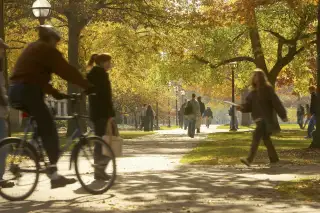Federal Student Loan Borrowers Are in Financial Trouble Despite Paused Payments: NY Fed

People who have federal student loans are disproportionately struggling to pay their other bills, even though their student loan payments have been paused since March 2020.
Those borrowers would be in even deeper financial trouble when payments finally resume if President Joe Biden's student loan forgiveness plan is blocked, a study from the New York Federal Reserve suggests.
Economists at the NY Fed analyzed the credit reports of borrowers with federal student loans and compared them with other types of student loan borrowers as well as folks with no student debt at all. They found that those who have student loans that are potentially eligible for Biden’s forgiveness plan are more likely than their peers to be behind on their credit card and auto loan debts right now.
“These missed payments suggest that some federal student loan borrowers are having trouble meeting their monthly debt obligations even though student loan payments are not required,” the economists wrote. “We expect these delinquency patterns to worsen if federal student loan payments resume without relief.”
For context, the typical monthly payment for student loan borrowers is approximately $222, according to a separate study from the Federal Reserve.
Federal student loan borrowers have not been obligated to make those payments for the past 34 months. When payments resume later this year — assuming broad student loan forgiveness is struck down by the Supreme Court — borrowers who are already struggling would have to cope with the added burden of resumed payments that will likely total hundreds of dollars or more per month.
The pause on federal student loan payments was a lifeline for millions of borrowers throughout the pandemic. Former President Donald Trump initially enacted the payment freeze, and it has since been extended eight times.
The latest extension to the payment pause, made by the Biden Administration, is slated to expire later this summer after the Supreme Court rules on Biden’s student loan forgiveness plan. Currently, Biden’s plan to forgive up to $20,000 of debt per borrower is on hold due to legal challenges. The Supreme Court has agreed to hear the case, and oral arguments will start next month. A decision is expected by June. Regardless of the outcome, the payment pause will lift two months after the Supreme Court’s ruling.
However, if Biden’s plan is cleared by the Supreme Court, mass delinquencies and defaults for student loan borrowers could be avoided, according to the study. The authors estimate that about $441 billion of student loan debt is eligible for discharge. For at least 16 million borrowers, that translates into total forgiveness of their outstanding student debt.
“If the Biden Administration’s forgiveness plan is ultimately allowed to occur, it will mark the largest mass discharge of consumer debt in modern history,” the authors wrote. “Nearly forty percent of federal student loan borrowers would no longer have a balance, and millions more would have a smaller monthly payment when payments restart.”
Even if Biden’s plan proceeds, the authors note that it's not a panacea, and the underlying issue of ballooning costs of attending college remains.
“Amid rising tuition costs, student loan balances will resume their upward climb, leaving the challenge of financing higher education to the younger generations,” they wrote. “Absent direct policies to address this growing burden, taxpayers may be again called to for relief in the future.”
More from Money:
Money’s Best Colleges in America
4 Facts That Show Who Benefits Most From Student Loan Forgiveness